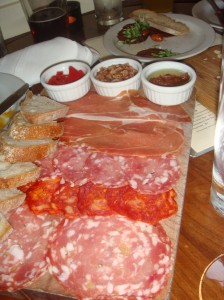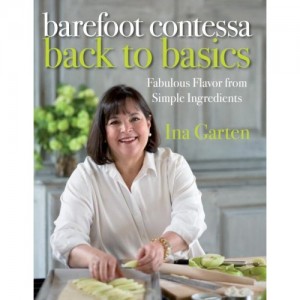I have been ordered by the Powers That Be to blog today, and now that I’ve sufficiently recovered from the shock of Ms Sunny Anderson commenting here, I suppose I have no choice but to comply.
This past Friday found yours truly in Philadelphia, a city that, albeit its close proximity to my current residence, I avoid like I would avoid a child with head lice. Some mates from my stint at Oxford were in town (doing a sort of fly-by-the-seat-of-your-pants East Coast tour), and my dear friend Catherine organized a mini-reunion. I’d rather be in NYC, but I could never turn down such good company and a chance for some tasty food.
Thus we arrived at Tria, a small-plates bar that focuses on its strong selection of three different items: wine, beer, and cheese (hence the name ‘Tria’). When we got there — just shy of 6 pm — the place was already jumping with the post-work drink crowd, and the scene was casual/trendy, full of late-20s/mid-30s. I wouldn’t go in looking like a hobo, but as long as you’re not an absolute fashion twat anyone can fit right in. All and all, it was a cute place, in the “we’ve got a swank bar, 90s emo music, and cram a lot of people into a narrow space” pretentious kind of way, but I’ve been in seventeen bajillion wine bars before (yes, seventeen bajillion), and the real test was all about the food and drink.
I was immediately amused by the word choices on the menu. My eye shot straight to the category called “Zippy Whites” — wines that promised a perky, tangy, and overful joyful drinking experience. I had two glasses of the ’09 Sauvignon Blanc ($8/glass) and shortly thereafter all was zippy indeed. While I didn’t partake in the beer, my friends did, and I had a gander at the selection; beers ranged from locally-brewed brands like Dogfish Head (Delaware) to some of the higher-alcohol Belgian beers that I prefer, like Maredsous 8.
The food, however, is where Tria truly shines. As stated on the website, most of the bar’s food (served tapas-style) is priced under $10. This is actually misleading, as I would go so far as to say most food is priced around $8 bucks — which is amazing if you share with friends. Granted, the portions aren’t huge, but they shouldn’t be. Small plates!
Our first choice, of course, was cheese; we had to experience the third part of Tria’s claim to fame. Since we had some fine English gentlemen in our party, Catherine and I ordered (and subsequently devoured with gusto) the Cabot Clothbound Cheddar (Vermont, $7.50), as the menu boasted that this New England cheese kicks the curd out of its British cousins. Whether it really does or not is debatable, but it was still damn good cheese.
Among our favorites that evening were the mole-spiced salami with honeyed almonds (about which I exclaimed, “This tastes like Christmas!”), warm Tuscan white bean spread (“Hey, this tastes like Mexico!”), Tuscan three-cheese potato chips with herbed truffle aioli (I ate the remaining aioli with a spoon), and the Italian meats platter with pickled red peppers, pickled onion mostarda, and garlic oil (I ate the remaining mustard with a spoon). We also had two types of bruschetta: goat cheese, garlic, and basil pesto, which I said tasted like summer (Catherine said it tasted like grass), and pistachio herbed ricotta with lavender honey (which was unanimously described as sex).
When we broke down the bill and factored in tip, it came to $26 per person. Considering we were all quite full and a little buzzy off good liquor, I call this place a bargain and a half. A place like this could easily mark up its food prices by 20% and still be considered fair; if this were NYC, I imagine it would have run at least $35/person.
The next time I venture to Philly, I’ll be sure to stop by Tria again, though I wouldn’t go so far as to drive into the city for the sole purpose of visiting this restaurant. Kudos to Catherine, whose love of cheese led us to a perfect spot for an Oxford reunion.





